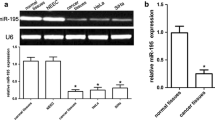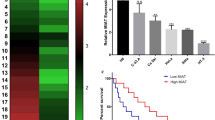Abstract
Cervical cancer is one of the most frequent gynecological malignancies in women worldwide. MicroRNA-195 (miR-195) was recently found highly expressed in cervical cancer. However, the role of miR-195 in the pathology of cervical cancer remains poorly understood. In this study, we first confirmed the downregulation of miR-195 in primary cervical cancer tissues. For the functional study, we introduced the sequences of miR-195 or miR-195 inhibitor into Hela and SiHa cervical cancer cell lines. Overexpression of miR-195 inhibited the proliferation of both Hela and SiHa cells. In contrast, reducing the endogenous miR-195 level by miR-195 inhibitor promoted the proliferation of cervical cancer cells. Flow cytometric assay showed that overexpression of miR-195 induced G1 phase arrest, whereas miR-195 inhibitor shortened G1 phase of cervical cancer cells. In addition, the suppressive role of miR-195 in cell cycle was also demonstrated by the western blot results of various cell cycle indicators, such as phosphorylated retinoblastoma (p-Rb) and proliferating cell nuclear antigen (PCNA), in the gain and loss of function experiments. Furthermore, Dual-Luciferase Reporter Assay revealed that miR-195 targeted the 3′-untranslated region of cyclin D1a transcript, such as to regulate cyclin D1 expression. In summary, our results suggest that miR-195 acts as a suppressor in the proliferation and cell cycle of cervical cancer cells by directly targeting cyclin D1a mRNA.






Similar content being viewed by others
References
Benard VB, Thomas CC, King J, Massetti GM, Doria-Rose VP, Saraiya M, et al. Vital signs: cervical cancer incidence, mortality, and screening—United States, 2007–2012. MMWR Morb Mortal Wkly Rep. 2014;63(44):1004–9.
Wang SM, Qiao YL. Implementation of cervical cancer screening and prevention in China—challenges and reality. Jpn J Clin Oncol. 2015;45(1):7–11.
Scheurer ME, Tortolero-Luna G, Adler-Storthz K. Human papillomavirus infection: biology, epidemiology, and prevention. Int J Gynecol Cancer. 2005;15(5):727–46.
Dizon DS, Mackay HJ, Thomas GM, Werner TL, Kohn EC, Hess D, et al. State of the science in cervical cancer: where we are today and where we need to go. Cancer. 2014;120(15):2282–8.
Ramirez PT, Pareja R, Rendon GJ, Millan C, Frumovitz M, Schmeler KM. Management of low-risk early-stage cervical cancer: should conization, simple trachelectomy, or simple hysterectomy replace radical surgery as the new standard of care? Gynecol Oncol. 2014;132(1):254–9.
Bartel DP. MicroRNAs: genomics, biogenesis, mechanism, and function. Cell. 2004;116(2):281–97.
Garzon R, Calin GA, Croce CM. MicroRNAs in cancer. Annu Rev Med. 2009;60:167–79.
Bhardwaj A, Singh S, Singh AP. MicroRNA-based cancer therapeutics: big hope from small RNAs. Mol Cell Pharmacol. 2010;2(5):213–9.
He JF, Luo YM, Wan XH, Jiang D. Biogenesis of miRNA-195 and its role in biogenesis, the cell cycle, and apoptosis. J Biochem Mol Toxicol. 2011;25(6):404–8.
Liu L, Chen L, Xu Y, Li R, Du X. MicroRNA-195 promotes apoptosis and suppresses tumorigenicity of human colorectal cancer cells. Biochem Biophys Res Commun. 2010;400(2):236–40.
Li D, Zhao Y, Liu C, Chen X, Qi Y, Jiang Y, et al. Analysis of miR-195 and miR-497 expression, regulation and role in breast cancer. Clin Cancer Res. 2011;17(7):1722–30.
Lin Y, Wu J, Chen H, Mao Y, Liu Y, Mao Q, et al. Cyclin-dependent kinase 4 is a novel target in microRNA-195-mediated cell cycle arrest in bladder cancer cells. FEBS Lett. 2012;586(4):442–7.
Zhang QQ, Xu H, Huang MB, Ma LM, Huang QJ, Yao Q, et al. MicroRNA-195 plays a tumor-suppressor role in human glioblastoma cells by targeting signaling pathways involved in cellular proliferation and invasion. Neuro Oncol. 2012;14(3):278–87.
Xu T, Zhu Y, Xiong Y, Ge YY, Yun JP, Zhuang SM. MicroRNA-195 suppresses tumorigenicity and regulates G1/S transition of human hepatocellular carcinoma cells. Hepatology. 2009;50(1):113–21.
Sekiya Y, Ogawa T, Iizuka M, Yoshizato K, Ikeda K, Kawada N. Down-regulation of cyclin E1 expression by microRNA-195 accounts for interferon-beta-induced inhibition of hepatic stellate cell proliferation. J Cell Physiol. 2011;226(10):2535–42.
Hui W, Yuntao L, Lun L, WenSheng L, ChaoFeng L, HaiYong H, et al. MicroRNA-195 inhibits the proliferation of human glioma cells by directly targeting cyclin D1 and cyclin E1. PLoS One. 2013;8(1), e54932.
Park H, Lee MJ, Jeong JY, Choi MC, Jung SG, Joo WD, et al. Dysregulated microRNA expression in adenocarcinoma of the uterine cervix: clinical impact of miR-363-3p. Gynecol Oncol. 2014;135(3):565–72.
Chen C, Ridzon DA, Broomer AJ, Zhou Z, Lee DH, Nguyen JT, et al. Real-time quantification of microRNAs by stem-loop RT-PCR. Nucleic Acids Res. 2005;33(20), e179.
Oppitz U, Schulte S, Stopper H, Baier K, Muller M, Wulf J, et al. In vitro radiosensitivity measured in lymphocytes and fibroblasts by colony formation and comet assay: comparison with clinical acute reactions to radiotherapy in breast cancer patients. Int J Radiat Biol. 2002;78(7):611–6.
Massague J. G1 cell-cycle control and cancer. Nature. 2004;432(7015):298–306.
Strzalka W, Ziemienowicz A. Proliferating cell nuclear antigen (PCNA): a key factor in DNA replication and cell cycle regulation. Ann Bot. 2011;107(7):1127–40.
Guo J, Miao Y, Xiao B, Huan R, Jiang Z, Meng D, et al. Differential expression of microRNA species in human gastric cancer versus non-tumorous tissues. J Gastroenterol Hepatol. 2009;24(4):652–7.
Heneghan HM, Miller N, Lowery AJ, Sweeney KJ, Newell J, Kerin MJ. Circulating microRNAs as novel minimally invasive biomarkers for breast cancer. Ann Surg. 2010;251(3):499–505.
Hansen J, Bross P. A cellular viability assay to monitor drug toxicity. Methods Mol Biol. 2010;648:303–11.
Liu D, Feng X, Wu X, Li Z, Wang W, Tao Y, et al. Tumor suppressor in lung cancer 1 (TSLC1), a novel tumor suppressor gene, is implicated in the regulation of proliferation, invasion, cell cycle, apoptosis, and tumorigenicity in cutaneous squamous cell carcinoma. Tumour Biol. 2013;34(6):3773–83.
Park MT, Lee SJ. Cell cycle and cancer. J Biochem Mol Biol. 2003;36(1):60–5.
Arato-Ohshima T, Sawa H. Over-expression of cyclin D1 induces glioma invasion by increasing matrix metalloproteinase activity and cell motility. Int J Cancer. 1999;83(3):387–92.
Sutherland RL, Musgrove EA. Cyclins and breast cancer. J Mammary Gland Biol Neoplasia. 2004;9(1):95–104.
Chakravarti A, Delaney MA, Noll E, Black PM, Loeffler JS, Muzikansky A, et al. Prognostic and pathologic significance of quantitative protein expression profiling in human gliomas. Clin Cancer Res. 2001;7(8):2387–95.
Acknowledgments
This study was supported by grants from the National Nature Science Foundation of China (No. 81202047), the Program for Liaoning Excellent Talents in University (No. LJQ2013083), the Higher Specialized Research Fund for the Doctoral Program (No. 20122104110014), and the Free Researcher Project of Shengjing Hospital (No. 201302).
Author information
Authors and Affiliations
Corresponding author
Ethics declarations
Conflicts of interest
None
Rights and permissions
About this article
Cite this article
Wang, N., Wei, H., Yin, D. et al. MicroRNA-195 inhibits proliferation of cervical cancer cells by targeting cyclin D1a. Tumor Biol. 37, 4711–4720 (2016). https://doi.org/10.1007/s13277-015-4292-3
Received:
Accepted:
Published:
Issue Date:
DOI: https://doi.org/10.1007/s13277-015-4292-3




